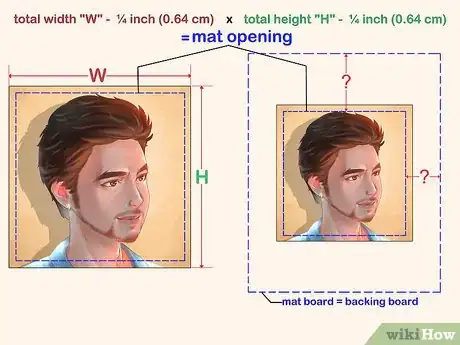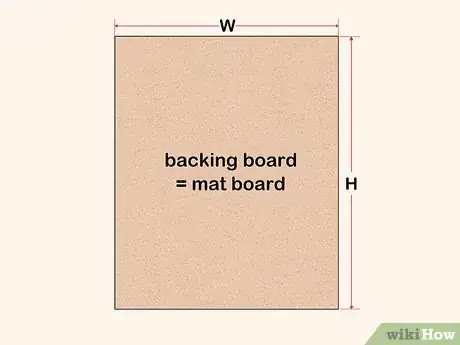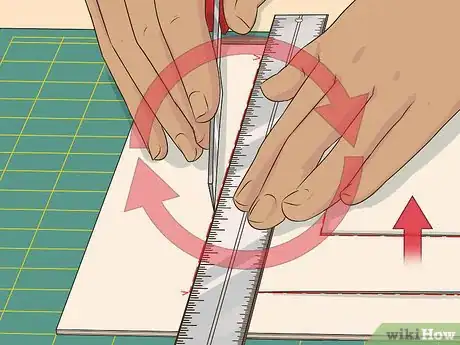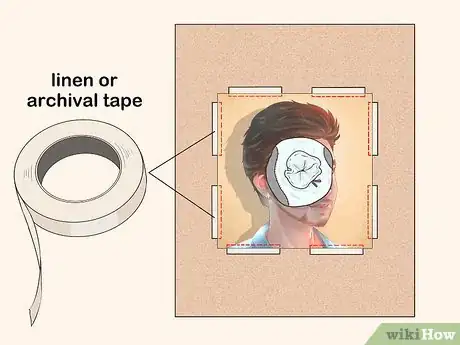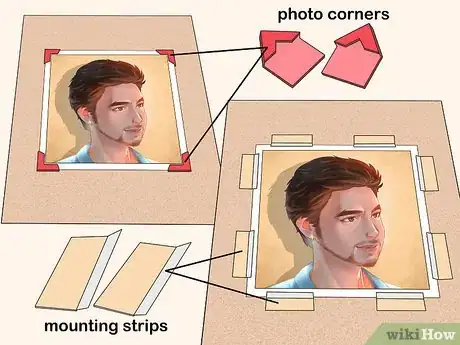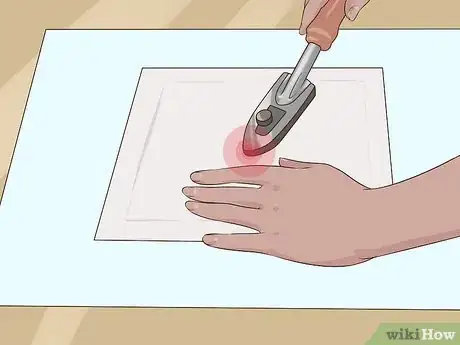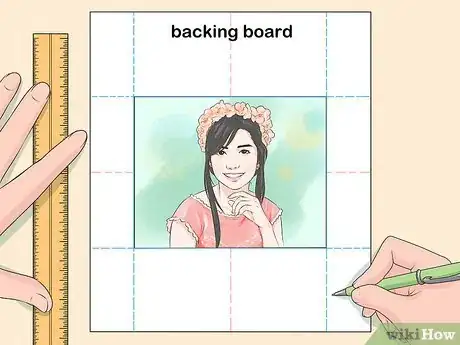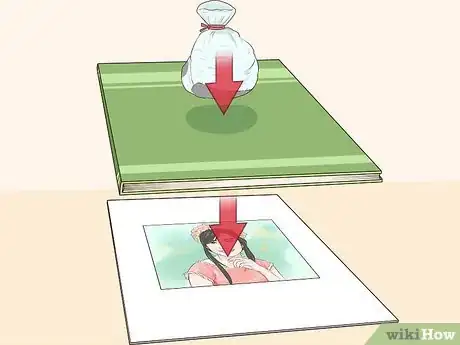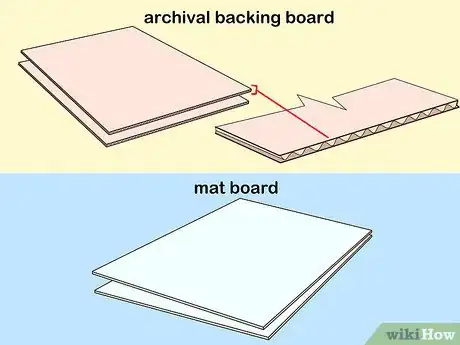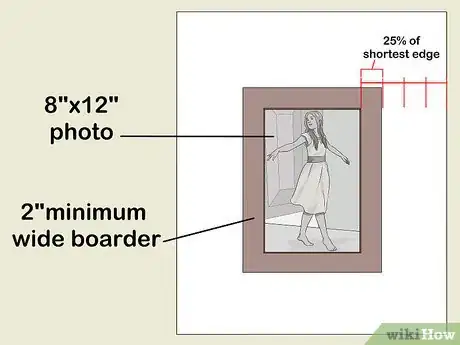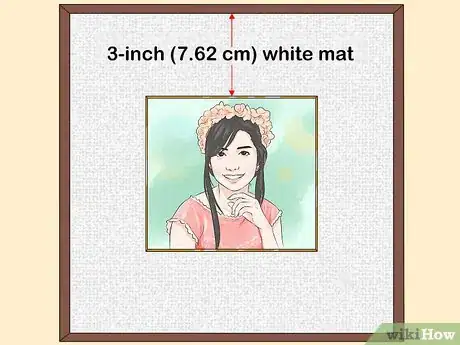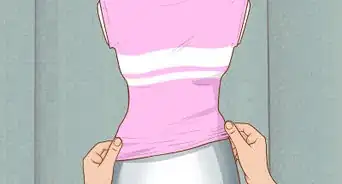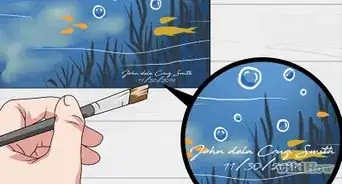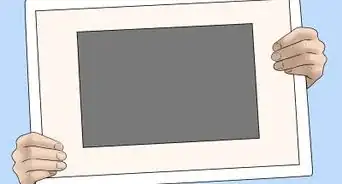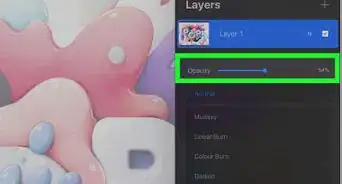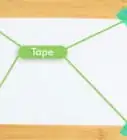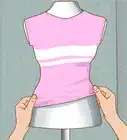This article was co-authored by Crystal Bear. Crystal Bear is a Professional Photographer and the Owner of Summer Bear Photography. Crystal specializes in weddings and portraits for women. She holds a BS in Interior Design and Consumer Science from San Francisco State University. Coming from a design background, Crystal brings a sense of style and artistry to her work that brings out her client’s inner confidence, showcases their beauty both inside and out, and puts them at ease. She also specializes in using the correct lighting and branding for women entrepreneurs.
There are 9 references cited in this article, which can be found at the bottom of the page.
This article has been viewed 44,702 times.
Matting is a great way to protect to your artwork while also showing it off. You can choose mats in a variety of colors, sizes, and materials to create the perfect mat board frame for your pieces. Learning how to mat artwork on your own will take some time and practice. It’ll be worth it, though, as it’ll save you from cringing over the high costs of taking your art to be matted at frame shops.
Steps
Cutting a Mat Board Window
-
1Choose a clean space for matting. Wipe the space down with a damp cloth and then completely dry it. As you’re going to be using your mat board to display your artwork, you don’t want it to get covered in dirt and grime! You’ll also be using your art to make proper measurements, so it’s extra important to have a clean work space.[1]
- Don’t use cleaning solutions or soap to clean your workspace, as these could damage your materials.
-
2Measure your artwork and mat border for the total board size. This is going to require some math, so break out your calculator. First, you need to decide how wide you’d like the mat border to be. Next, measure the width and length of your artwork. This will give you the size you need to cut out the window (the cut-out that will display the artwork). Add the window and border measurements for the total mat board size.[2]
- If you’re not showing any border or edges on the side of the artwork, you may want to subtract ¼ inch (0.64 cm) from each side (½ inch or 1.27 cm total for both length and width). This will give you a neat edge underneath your mat board.
- Your mat board should match up in size with your backing. Once you’ve got the mat board measured, use these measurements to size out the backing as well.
Advertisement -
3Mark the outer edges of the mat and backing boards. Most boards come in standard sizes that will need to be trimmed to fit your artwork. Now that you’ve got your measurements, use a tape measure or ruler and make two light pencil marks in each corner to record them.[3]
-
4Use the back of your frame for measurements. If you’re going to frame your matted art, both your backing and the mat boards need to be measured to fit into the frame. Use the back of the frame to make sure you’ve got these measurements right. If your backing and mat boards are too big, you may need to trim down the border size.[4]
- Having a frame before you start matting limits your flexibility on sizing the mat board border, so you may want to wait to pick a frame until after everything’s already matted.
-
5Use a ruler and pencil to trace your measurements. Remove your artwork from the backing and mat boards and set it to the side. Use a ruler to make straight lines connecting each of the small marks you just made. You should have two rectangles or squares on your mat board and one on your backing.[5]
-
6Use a straight-edge razor to cut the backing and mat boards. Press the razor down firmly at the top corners of the boards. Pull the razor slowly and steadily towards you, stopping at the bottom corner. Keep the same pressure throughout your cut, and be very careful not to dip out or in from the penciled line.[6]
- Keeping the line straight is the toughest part of this whole process. It’s also frustrating, because you’ll have to start over if your lines aren’t straight. Use something with a straight edge, such as an old frame or a heavy book, to help you cut.
-
7Cut twice so the mat pops out of the window. You shouldn’t need to use any force to remove the cut out, as this could rip the mat board window. Make the cuts at least twice to allow the cut out to simply fall out of the window. Make sure you’re cutting on the exact same lines each time.[7]
- You may need to make several cuts to remove the cut out. Do as many as you need to, but take your time. Each repeated cut needs to be on the same line as all the others.
Mounting Your Artwork with Tape
-
1Measure to center your artwork on the backing. Place your artwork on the backing and measure the space on each side. You should have the same amount of blank space above and below the artwork, as well as on the left and right sides of the piece. Make small pencil marks in the corners on the backing to record the right spot.[8]
-
2Check your centering by laying down your window. It’s a good idea to make sure your centering looks right with the window on top of the artwork. This will give you an idea of what your final, matted piece is going to look like. Take a minute to enjoy it before you get back to work.[9]
-
3Use a weight to keep your artwork in place. Now that everything’s centered, it’s time to start attaching all the pieces to one another. Use something heavy, like a sock filled with coins or a heavy glass, to keep your artwork where you want it. Don’t worry too much if it shifts, though, since you’ve made marks to keep track of the centering.
-
4Tape the back of your art to the backing. Use linen or archival tape to create what’s called a hinge to attach your window to the backing. Put two pieces of tape in vertical lines on each side of the back of the piece, so the sticky side doesn’t touch the backing. Lay two more pieces of tape horizontally across the vertical pieces (sticky-side down) to adhere the artwork to the backing.
- Linen and archival tape has the adhesive ability of regular tape, but it won’t damage your artwork or mat board. It’ll cost more than normal tape, but regular household tape contains acids and other chemicals that may eventually leak onto your artwork.
-
5Use photo corners or mounting strips to attach your artwork. If you’re using corners, take off the bottom adhesive and place four of them on the backing at each corner of the piece. For see-through mounting strips, use two on each side of the piece, or eight total, and adhere them to the backing. You can then slip the artwork directly under the corners or strips.
- Photo corners and strips are best for conservation, as they avoid the damage that even linen tape could cause to your piece.
-
6Attach the window mat by creating a taped hinge. Lay down the window and the backing flush against each other, with the window face down. Use one long strip of linen tape to connect the window to the backing. Place the tape so one half is on the back of the window and one half is on the backing. Fold them together like you’re closing a book.
- It’s best to connect the window and backing at the top of the frame.
- You’re now ready to put this matted print into a frame if you’d like a more finished look. You can also attach an adhesive picture hanger to the back of your backing board to hang the matted frame up on the wall by itself.
Dry Mounting Your Artwork
-
1Purchase equipment if you plan to dry mount. Dry mounting (rather than using tape) is a more involved process. If you want a permanent and extremely stable mount and you don’t mind opening your wallet, go for it! You’ll need a tacking iron, dry mounting and release tissues, and a professional heating press.[10]
- Investing in dry mounting equipment may be a great idea if you know you want to consistently mount lots of artwork or photographs.
- This really will be an investment. Dry mount presses cost a few thousand dollars, and tacking irons may cost between $50-$100. The tissues will be less pricey.
- Be aware that dry mounting isn’t recommended for older artwork or pieces you’d like to preserve. It’s a permanent, irreversible process, so it’s not the best option for conservation.
-
2Measure your artwork and window to size the backing board. It’s time for math! Pick the size you’d like for the border of your window. Measure your artwork. Add these two numbers together to calculate how large the backing needs to be. Make two pencil marks in the corners to record your measurements.[11]
-
3Place artwork face down to lay dry mounting tissue behind it. Make sure you’ve got a clean space for this step. Once you’ve put down your artwork, lay a sheet of dry mounting tissue over it. It should cover the artwork completely. You’ll trim off the excess later.[12]
-
4Attach the center of the print to the tissue with a heated tacking iron. Most tacking irons can be plugged in to heat them up, just like normal irons. Once you’ve let your iron get toasty, place it in the center of the face-down artwork and dry mounting tissue. Iron the tissue for a few seconds in a small circle to adhere it to the back of the piece.
-
5Trim off the excess dry mounting tissue. Use scissors or a paper trimmer to carefully cut off the extra dry mounting tissue. Go slowly. You need neat, straight lines, and you don’t want to cut your artwork by accident.[13]
- If you have access to a large paper trimmer, this will make cutting the tissue much easier and neater.
-
6Measure to center your artwork on its backing. Place the artwork face up on its backing. Use a tape measure to check its placement. You should have the same amount of extra space on the left and right sides, as well as on the top and bottom of the piece. Make pencil marks on the backing to mark the spot.[14]
-
7Use the tacking iron to attach two corners to the backing. Gently lift up two corners of the piece, one at a time. Take your heated tacking iron and adhere the dry mounting tissue, which should be laying flat on the backing, to the backing. Pull the tacking iron from the center outwards. Adhere two opposite corners.[15]
-
8Press your print in a heated press for about 1-2 minutes. Lift up the press cover and slip your piece inside two pieces of leftover mat board and release paper. Close the press. It should be heated to about 180℉ (82.22℃). Use a stopwatch to keep track of the time.[16]
- For photographs, resin-based paper should only be heated for about 60-90 seconds, while fiber-based papers should be heated for 2-4 minutes. Fiber-based paper is the material that’s more commonly used to print high-quality pictures.[17]
-
9Weigh down the mounted print while it cools. You don’t want the board to warp or bubble during the cooling process. Once you remove it from the press, keep it flat by laying it face down underneath something heavy. The artwork needs to be fully cooled before you remove it from under the weight. Test it by lifting one corner and gently touching your finger to the backing.[18]
- Use a large coffee-table book or several socks with coins in them if you don’t have a flattening weight specially made for the dry mounting process.
- Make sure your workspace is still clean before you lay your artwork face down to cool.
Choosing the Right Mat for Your Artwork
-
1Choose archival backing and mat boards for original artwork. Archival materials are designed to preserve artwork by using acid-free paper that won’t damage your pieces. This is the stuff that museums use on their collections, so you know it’s high quality. These materials will cost you a little more. However, if you’re matting expensive prints or original artwork, this is the way to go.[19]
-
2Choose standard backing and mats boards for less valuable art. If you’re matting a print that’s less expensive, you may not be as concerned with damage. Be aware that while it may take years for standard backing and mat boards to affect your prints, it will happen eventually. If you’re matting something that you care about (even if it’s not pricey!), pick the archival-quality materials.[20]
-
3Use a wide mat border for smaller pieces. To highlight smaller artwork or photographs, set them in wide-bordered mats. This will make the piece look more dramatic. It’ll also draw observers’ attention to the center of the piece.[21]
- Measuring the border will depend on the size of the piece. Your border should measure as wide as at least 25% of the shortest edge. So if your piece is 8 in. by 12 in. (20.32 cm by 30.48 cm), you’ll need a minimum of 2 inches (5.08 cm) for the border. Go up an inch or two (2.54-5.08 cm) to make this a wider border.[22]
-
4Use a narrow mat border for large, impressive pieces. Larger artwork generally speaks for itself. It doesn’t need any added flair. It’s especially important to keep elaborate or detailed large pieces in windows with thin borders.[23]
- Keep your border at the minimum measurement (25% of the shortest edge) for a narrow width.
-
5Choose white matting to limit distractions from the art. Don’t think of white as boring, as white will allow your pieces to shine all on their own. White matting also provides a clean look. White is perfect for original artwork, as it’ll allow observers to focus only on the art itself.[24]
-
6Choose neutrals for a soft but subtle mat. If you’d like to add a little more character to your matting without distracting from the artwork, try other neutrals. Grays, beiges, and off-whites can all be great choices. This can allow you to add diversity to your mat boards without overshadowing your pieces.[25]
-
7Choose colors that don’t compete with the artwork. If you do decide to go with other colors, choose carefully. You need colors that complement the artwork, rather than competing with it. Try choosing a color that’s already present in the piece to draw it out a bit.[26]
- If you have a piece that’s mostly orange, for example, don’t go with a blue mat board.
- Avoid mats that are darker or brighter than the artwork. If you really want to add color, put bright or bold colors on the bottom, thinner layer of a double mat.[27]
-
8
Expert Q&A
-
QuestionWhat does it mean to mat artwork?
 Crystal BearCrystal Bear is a Professional Photographer and the Owner of Summer Bear Photography. Crystal specializes in weddings and portraits for women. She holds a BS in Interior Design and Consumer Science from San Francisco State University. Coming from a design background, Crystal brings a sense of style and artistry to her work that brings out her client’s inner confidence, showcases their beauty both inside and out, and puts them at ease. She also specializes in using the correct lighting and branding for women entrepreneurs.
Crystal BearCrystal Bear is a Professional Photographer and the Owner of Summer Bear Photography. Crystal specializes in weddings and portraits for women. She holds a BS in Interior Design and Consumer Science from San Francisco State University. Coming from a design background, Crystal brings a sense of style and artistry to her work that brings out her client’s inner confidence, showcases their beauty both inside and out, and puts them at ease. She also specializes in using the correct lighting and branding for women entrepreneurs.
Professional Photographer Mats are the borders that wrap around an image sitting in a frame. They add an extra visual element and can really make a work pop!
Mats are the borders that wrap around an image sitting in a frame. They add an extra visual element and can really make a work pop! -
QuestionWhen should you mat a picture?
 Crystal BearCrystal Bear is a Professional Photographer and the Owner of Summer Bear Photography. Crystal specializes in weddings and portraits for women. She holds a BS in Interior Design and Consumer Science from San Francisco State University. Coming from a design background, Crystal brings a sense of style and artistry to her work that brings out her client’s inner confidence, showcases their beauty both inside and out, and puts them at ease. She also specializes in using the correct lighting and branding for women entrepreneurs.
Crystal BearCrystal Bear is a Professional Photographer and the Owner of Summer Bear Photography. Crystal specializes in weddings and portraits for women. She holds a BS in Interior Design and Consumer Science from San Francisco State University. Coming from a design background, Crystal brings a sense of style and artistry to her work that brings out her client’s inner confidence, showcases their beauty both inside and out, and puts them at ease. She also specializes in using the correct lighting and branding for women entrepreneurs.
Professional Photographer It's really up to you. Matting a photo or a work of art changes the way it looks. It changes the way your home looks. The thing is, what looks good to you may not look good to me and vice versa. All of this is to say that it's totally up to you. If you think a mat would look good, go for it!
It's really up to you. Matting a photo or a work of art changes the way it looks. It changes the way your home looks. The thing is, what looks good to you may not look good to me and vice versa. All of this is to say that it's totally up to you. If you think a mat would look good, go for it!
Things You’ll Need
- Artwork
- Cleaning cloths
- Mat and backing boards, either archival or standard
- Straight-edge razor
- Ruler or tape measure
- Pencil
- Linen or archival tape
- Photo corners
- See-through mounting strips
- Adhesive picture hanger or frame
- Dry mounting press
- Tacking iron
- Dry mounting tissue
- Release tissue
- Weight (sock filled with coins, heavy book or glass)
References
- ↑ https://www.apartmenttherapy.com/how-to-cut-a-mat-for-framing-artwork-176545
- ↑ http://www.logangraphic.com/blog/how-to-measure-for-mat-cutting-and-picture-framing/
- ↑ https://www.apartmenttherapy.com/how-to-cut-a-mat-for-framing-artwork-176545
- ↑ http://www.logangraphic.com/blog/how-to-measure-for-mat-cutting-and-picture-framing/
- ↑ https://www.apartmenttherapy.com/how-to-cut-a-mat-for-framing-artwork-176545
- ↑ https://www.apartmenttherapy.com/how-to-cut-a-mat-for-framing-artwork-176545
- ↑ https://www.apartmenttherapy.com/how-to-cut-a-mat-for-framing-artwork-176545
- ↑ Crystal Bear. Professional Photographer. Expert Interview. 21 January 2021.
- ↑ Crystal Bear. Professional Photographer. Expert Interview. 21 January 2021.
- ↑ https://www.reframingphotography.com/content/mounting-matting-and-framing
- ↑ https://www.reframingphotography.com/content/mounting-matting-and-framing
- ↑ https://www.reframingphotography.com/content/mounting-matting-and-framing
- ↑ https://www.reframingphotography.com/content/mounting-matting-and-framing
- ↑ https://www.reframingphotography.com/content/mounting-matting-and-framing
- ↑ https://www.reframingphotography.com/content/mounting-matting-and-framing
- ↑ https://www.reframingphotography.com/content/mounting-matting-and-framing
- ↑ https://parallaxphotographic.coop/photographic-resources/the-difference-between-resin-coated-and-fibre-based-paper/
- ↑ https://www.reframingphotography.com/content/mounting-matting-and-framing
- ↑ https://www.diplomaframe.com/chc-blog/choosing-the-right-mat/
- ↑ https://www.diplomaframe.com/chc-blog/choosing-the-right-mat/
- ↑ https://www.houzz.com/ideabooks/653859/list/the-right-mat-for-your-artwork
- ↑ https://www.metroframe.com/mat-and-float-presentations/
- ↑ https://www.houzz.com/ideabooks/653859/list/the-right-mat-for-your-artwork
- ↑ https://www.houzz.com/ideabooks/653859/list/the-right-mat-for-your-artwork
- ↑ https://www.houzz.com/ideabooks/653859/list/the-right-mat-for-your-artwork
- ↑ http://www.carteravenueframeshop.com/framing-info/framing-design/how-to-choose-mat-colors/
- ↑ https://www.houzz.com/ideabooks/653859/list/the-right-mat-for-your-artwork
- ↑ Crystal Bear. Professional Photographer. Expert Interview. 21 January 2021.
- ↑ https://www.houzz.com/ideabooks/653859/list/the-right-mat-for-your-artwork

